Performance of Green Areas in Mitigating the Alteration of Land Surface Temperature in Urban Zones of Lima, Peru
Abstract
1. Introduction
2. Materials and Methods
2.1. Study Area
2.2. Source of Spatial Data
2.2.1. Information Source for Urban Area Delimitation
2.2.2. Land Surface Temperature (LST)
2.2.3. Fractional Vegetation Cover (FVC)
2.3. Mann–Kendall Trend Analysis
2.4. Complementary Statistical Analyses
2.4.1. Correlation Analysis Between FVC and LST
2.4.2. Multivariate Analysis
3. Results
3.1. Proportion of Green Areas by Districts
3.2. Trend Results of FVC and LST
3.3. Trend Relationship Between FVC and LST
3.4. Spearman Relationship Between FVC and LST for the Period 1986–2024
3.5. Identification, Categorization, and Classification of Districts Based on Trend Characteristics and Correlation of FVC and LST
- Cluster 1: This cluster comprises 14 districts with small, recently created green patches with limited spatial connectivity (lacking biological corridors). Additionally, these districts exhibit extensive horizontal urban development. This cluster shows a highly significant positive trend in FVC (p < 0.001) and LST (p < 0.001), indicating a highly significant positive correlation as well (p < 0.001).
- Cluster 2: Includes 11 districts, the largest in area, located in the city’s peripheral zones. It shows a highly significant positive trend in LST (p < 0.001) and a highly significant negative trend in FVC (p < 0.001) attributed to vegetation loss. Moreover, it presents a weakly significant negative correlation (p < 0.05). These districts had extensive agricultural areas at the beginning of the evaluation period.
- Cluster 3: Comprises 12 districts with unique behavior, displaying a significant positive trend in LST (p < 0.05) and a weakly significant negative trend in FVC (p < 0.05). The mitigation of LST changes could be attributed to sea breeze effects due to proximity to the ocean and artificial water bodies created for industrial purposes. The correlation is low in this case, showing a non-significant positive correlation (p > 0.05).
- Cluster 4: Includes 13 districts with a significant positive trend in LST (p < 0.05) and a highly significant positive trend in FVC (p < 0.001). These districts contain larger green areas that have consistently increased throughout the evaluation period. They are notable for their commitment to green space implementation and exhibit high interconnectivity, including the presence of biological corridors, considering their spatially interconnected configuration.
4. Discussion
5. Conclusions
Author Contributions
Funding
Data Availability Statement
Conflicts of Interest
References
- Bowler, D.E.; Buyung-Ali, L.; Knight, T.M.; Pullin, A.S. Urban greening to cool towns and cities: A systematic review of the empirical evidence. Landsc. Urban Plan. 2010, 97, 147–155. [Google Scholar] [CrossRef]
- Blachowski, J.; Hajnrych, M. Assessing the Cooling Effect of Four Urban Parks of Different Sizes in a Temperate Continental Climate Zone: Wroclaw (Poland). Forests 2021, 12, 1136. [Google Scholar] [CrossRef]
- Selim, S.; Eyileten, B.; Karakuş, N. Investigation of green space cooling potential on land surface temperature in Antalya city of Turkey. ISPRS—Int. Arch. Photogramm. Remote Sens. Spat. Inf. Sci. 2023, XLVIII-M-1, 107–114. [Google Scholar] [CrossRef]
- Adulkongkaew, T.; Satapanajaru, T.; Charoenhirunyingyos, S.; Singhirunnusorn, W. Effect of land cover composition and building configuration on land surface temperature in an urban-sprawl city, case study in Bangkok Metropolitan Area, Thailand. Heliyon 2020, 6, e04485. [Google Scholar] [CrossRef] [PubMed]
- Ahmed, B.; Kamruzzaman, M.; Zhu, X.; Rahman, M.S.; Choi, K. Simulating Land Cover Changes and Their Impacts on Land Surface Temperature in Dhaka, Bangladesh. Remote Sens. 2013, 5, 5969–5998. [Google Scholar] [CrossRef]
- Zhang, M.; Tan, S.; Zhang, C.; Han, S.; Zou, S.; Chen, E. Assessing the impact of fractional vegetation cover on urban thermal environment: A case study of Hangzhou, China. Sustain. Cities Soc. 2023, 96, 104663. [Google Scholar] [CrossRef]
- Arellano, B.; Roca, J. Effects of urban greenery on health. A study from remote sensing. Int. Arch. Photogramm. Remote Sens. Spat. Inf. Sci. 2022, XLIII-B3-2022, 17–24. [Google Scholar]
- D’isidoro, M.; Mircea, M.; Borge, R.; Finardi, S.; de la Paz, D.; Briganti, G.; Russo, F.; Cremona, G.; Villani, M.G.; Adani, M.; et al. The Role of Vegetation on Urban Atmosphere of Three European Cities—Part 1: Evaluation of Vegetation Impact on Meteorological Conditions. Forests 2023, 14, 1235. [Google Scholar] [CrossRef]
- Cai, Y.; Zhang, M.; Lin, H. Estimating the Urban Fractional Vegetation Cover Using an Object-Based Mixture Analysis Method and Sentinel-2 MSI Imagery. IEEE J. Sel. Top. Appl. Earth Obs. Remote Sens. 2020, 13, 341–350. [Google Scholar] [CrossRef]
- Asi, A.N.H.; Supriatna, S.; Zulkarnain, F. Spatial Study of Land Cover Changes and Land Surface Temperature in Bekasi Regency, West Java, Indonesia. IOP Conf. Ser. Earth Environ. Sci. 2022, 1111, 012024. [Google Scholar]
- Avdan, U.; Jovanovska, G. Algorithm for Automated Mapping of Land Surface Temperature Using LANDSAT 8 Satellite Data. J. Sens. 2016, 2016, 1480307. [Google Scholar] [CrossRef]
- Sekertekin, A.; Zadbagher, E. Simulation of future land surface temperature distribution and evaluating surface urban heat island based on impervious surface area. Ecol. Indic. 2021, 122, 107230. [Google Scholar] [CrossRef]
- Moisa, M.B.; Gabissa, B.T.; Hinkosa, L.B.; Dejene, I.N.; Gemeda, D.O. Analysis of Land Surface Temperature Using Geospatial Technologies in Gida Kiremu, Limu, and Amuru District, Western Ethiopia. Artif. Intell. Agric. 2022, 6, 90–99. [Google Scholar] [CrossRef]
- Marufuzzaman, M.; Khanam, M.M.; Hasan, K. Monitoring the Land Cover Change and Its Impact on the Land Surface Temperature of Rajshahi City, Bangladesh using GIS and Remote Sensing Techniques. J. Geogr. Environ. Earth Sci. Int. 2021, 25, 1–19. [Google Scholar] [CrossRef]
- Achmad, E.; Muryunika, R. Analysis of Vegetation Density and Land Surface Temperature Using Landsat Image in the Forest Area of KPHP Unit XII Batanghari. In Proceedings of the 3rd Green Development International Conference (GDIC 2020); Advances in Engineering Research. Atlantis Press: Dordrecht, The Netherlands, 2021; pp. 109–113. Available online: https://www.atlantis-press.com/proceedings/gdic-20/125960265 (accessed on 3 October 2024).
- Phan, T.N.; Kappas, M.; Tran, T.P. Land Surface Temperature Variation Due to Changes in Elevation in Northwest Vietnam. Climate 2018, 6, 28. [Google Scholar] [CrossRef]
- Zhao, L.; Lee, X.; Schultz, N.M. A wedge strategy for mitigation of urban warming in future climate scenarios. Atmos. Chem. Phys. 2017, 17, 9067–9080. [Google Scholar] [CrossRef]
- Fan, X.; Tang, B.-H.; Wu, H.; Yan, G.; Li, Z.-L. A three-channel algorithm for retrieving night-time land surface temperature from MODIS data under thin cirrus clouds. Int. J. Remote Sens. 2015, 36, 4836–4863. [Google Scholar] [CrossRef]
- Jiang, Y.; Fu, P.; Weng, Q. Assessing the Impacts of Urbanization-Associated Land Use/Cover Change on Land Surface Temperature and Surface Moisture: A Case Study in the Midwestern United States. Remote Sens. 2015, 7, 4880–4898. [Google Scholar] [CrossRef]
- Sresto, M.A.; Siddika, S.; Fattah, M.A.; Morshed, S.R.; Morshed, M.M. A GIS and remote sensing approach for measuring summer-winter variation of land use and land cover indices and surface temperature in Dhaka district, Bangladesh. Heliyon 2022, 8, e10309. [Google Scholar]
- INEI. Instituto Nacional de Estadistica e Informatica-Población de la Provincia de Lima Supera los 10 Millones 292 Mil Habitantes [Internet]. 2023. Available online: https://www.gob.pe/institucion/inei/noticias/894611-poblacion-de-la-provincia-de-lima-supera-los-10-millones-292-mil-habitantes (accessed on 4 October 2024).
- INEI. Instituto Nacional de Estadistica e Informatica-Provincia Constitucional del Callao Alberga a Cerca de un Millón de Habitantes [Internet]. 2023. Available online: https://m.inei.gob.pe/prensa/noticias/provincia-constitucional-del-callao-alberga-a-cerca-de-un-millon-de-habitantes-7689/ (accessed on 4 October 2024).
- World Population Review-Largest Cities by Population 2024 [Internet]. Available online: https://worldpopulationreview.com/cities (accessed on 4 October 2024).
- Moya, L.; Vilela, M.; Jaimes, J.; Espinoza, B.; Pajuelo, J.; Tarque, N.; Santa-Cruz, S.; Vega-Centeno, P.; Yamazaki, F. Vulnerabilities and exposure of recent informal urban areas in Lima, Peru. Prog. Disaster Sci. 2024, 23, 100345. [Google Scholar] [CrossRef]
- Cano, D.; Cacciuttolo, C.; Haller, A.; Rosario, C.; Guerra, J.C.; de Oliveira, G.G. Spatio-temporal tendencies of urban land surface temperature on the Andean piedmont under climate change: A case study of Metropolitan Lima, Peru (1986–2024). Remote Sens. Appl. Soc. Environ. 2024, 36, 101378. [Google Scholar] [CrossRef]
- Ascencio, E.J.; Barja, A.; Benmarhnia, T.; Carrasco-Escobar, G. Disproportionate exposure to surface-urban heat islands across vulnerable populations in Lima city, Peru. Environ. Res. Lett. 2023, 18, 074001. [Google Scholar] [CrossRef]
- Limache, C.T. Quantification of the benefits derived from the Nature Based Solutions in the very arid and densified urban context of metropolitan Lima. Rev. LABVERDE 2022, 12, 207–243. [Google Scholar] [CrossRef]
- Inostroza, L.; Csaplovics, E. Measuring Climate Change Adaptation in Latin-America. Spatial Indexes for Exposure, Sensitivity and Adaptive Capacity to Urban Heat Islands in Lima and Santiago de Chile; Lincoln Institute of Land Policy Working Paper; Lincoln Institute of Land Policy: Cambridge, CA, USA, 2014; 103p. [Google Scholar]
- Siña, M.; Wood, R.C.; Saldarriaga, E.; Lawler, J.; Zunt, J.; Garcia, P.; Cárcamo, C. Understanding Perceptions of Climate Change, Priorities, and Decision-Making among Municipalities in Lima, Peru to Better Inform Adaptation and Mitigation Planning. PLoS ONE 2016, 11, e0147201. [Google Scholar] [CrossRef]
- Cárdenas-Mamani, Ú.; Perrotti, D. An integrated urban metabolism and ecosystem service assessment: The case study of Lima, Peru. J. Ind. Ecol. 2024, 28, 1567–1581. [Google Scholar] [CrossRef]
- Moreno, R.; Nery, A.; Zamora, R.; Lora, Á.; Galán, C. Contribution of urban trees to carbon sequestration and reduction of air pollutants in Lima, Peru. Ecosyst. Serv. 2024, 67, 101618. [Google Scholar] [CrossRef]
- Facchini, A.; Mele, R.; Caldarelli, G. The Urban Metabolism of Lima: Perspectives and Policy Indications for GHG Emission Reductions. Front. Sustain. Cities 2021, 2, 40. [Google Scholar] [CrossRef]
- SENAMHI. Servicio Nacional de Meteorología e Hidrología del Perú-Lima Registró Lluvia de Moderada Intensidad [Internet]. 2020. Available online: https://www.senamhi.gob.pe/?p=prensa&n=1129 (accessed on 4 October 2024).
- APEC. Partnerships for the Sustainable Development of Cities in the APEC Region [Internet]. Cities Alliance. 2018. Available online: https://www.citiesalliance.org/resources/publications/cities-alliance-knowledge/partnerships-sustainable-development-cities-apec (accessed on 4 October 2024).
- Ermida, S.L.; Soares, P.; Mantas, V.; Göttsche, F.-M.; Trigo, I.F. Google Earth Engine Open-Source Code for Land Surface Temperature Estimation from the Landsat Series. Remote Sens. 2020, 12, 1471. [Google Scholar] [CrossRef]
- Gorelick, N.; Hancher, M.; Dixon, M.; Ilyushchenko, S.; Thau, D.; Moore, R. Google Earth Engine: Planetary-scale geospatial analysis for everyone. Remote Sens. Environ. 2017, 202, 18–27. [Google Scholar] [CrossRef]
- Good, E.J.; Aldred, F.M.; Ghent, D.J.; Veal, K.L.; Jimenez, C. An Analysis of the Stability and Trends in the LST_cci Land Surface Temperature Datasets Over Europe. Earth Space Sci. 2022, 9, e2022EA002317. [Google Scholar] [CrossRef]
- Wang, M.; Zhang, Z.; He, G.; Wang, G.; Long, T.; Peng, Y. An enhanced single-channel algorithm for retrieving land surface temperature from Landsat series data. J. Geophys. Res. Atmos. 2016, 121, 11712–11722. [Google Scholar] [CrossRef]
- Vermote, E.; Justice, C.; Claverie, M.; Franch, B. Preliminary Analysis of the Performance of the Landsat 8/OLI Land Surface Reflectance Product. Remote Sens. Environ. 2016, 185, 46–56. [Google Scholar] [CrossRef] [PubMed]
- Carlson, T.N.; Ripley, D.A. On the relation between NDVI, fractional vegetation cover, and leaf area index. Remote Sens. Environ. 1997, 62, 241–252. [Google Scholar] [CrossRef]
- Orusa, T.; Viani, A.; Moyo, B.; Cammareri, D.; Borgogno-Mondino, E. Risk Assessment of Rising Temperatures Using Landsat 4–9 LST Time Series and Meta® Population Dataset: An Application in Aosta Valley, NW Italy. Remote Sens. 2023, 15, 2348. [Google Scholar] [CrossRef]
- Qi, Y.; Li, H.; Pang, Z.; Gao, W.; Liu, C. A Case Study of the Relationship Between Vegetation Coverage and Urban Heat Island in a Coastal City by Applying Digital Twins. Front. Plant Sci. 2022, 13, 861768. [Google Scholar] [CrossRef]
- Zhang, S.; Chen, H.; Fu, Y.; Niu, H.; Yang, Y.; Zhang, B. Fractional Vegetation Cover Estimation of Different Vegetation Types in the Qaidam Basin. Sustainability 2019, 11, 864. [Google Scholar] [CrossRef]
- Cano, D.; Pizarro, S.; Cacciuttolo, C.; Peñaloza, R.; Yaranga, R.; Gandini, M.L. Study of Ecosystem Degradation Dynamics in the Peruvian Highlands: Landsat Time-Series Trend Analysis (1985–2022) with ARVI for Different Vegetation Cover Types. Sustainability 2023, 15, 15472. [Google Scholar] [CrossRef]
- Hauke, J.; Kossowski, T. Comparison of values of Pearson’s and Spearman’s correlation coefficients on the same sets of data. Quaest. Geogr. 2011, 30, 87–93. [Google Scholar] [CrossRef]
- Bonett, D.G.; Wright, T.A. Sample Size Requirements for Estimating Pearson, Kendall and Spearman Correlations. Psychometrika 2000, 65, 23–28. [Google Scholar] [CrossRef]
- Hijmans, R.J.; Etten, J.v.; Sumner, M.; Cheng, J.; Baston, D.; Bevan, A.; Bivand, R.; Busetto, L.; Canty, M.; Fasoli, B.; et al. Raster: Geographic Data Analysis and Modeling [Internet]. 2024. Available online: https://cran.r-project.org/web/packages/raster/index.html (accessed on 25 October 2024).
- Wickham, H.; François, R.; Henry, L.; Müller, K.; Vaughan, D.; Software, P. dplyr: A Grammar of Data Manipulation [Internet]. 2023. Available online: https://cran.r-project.org/web/packages/dplyr/index.html (accessed on 25 October 2024).
- Di Rienzo, J.; Casanoves, F.; Balzarini, M.; Gonzalez, L.; Tablada, M.; Robledo, C. InfoStat Versión 2020; Universidad Nacional de Córdoba: Cordoba, Argentina, 2020; Available online: http://www.infostat.com.ar (accessed on 27 October 2024).
- Fernández-de-Córdova, G.; Moschella, P.; Fernández-Maldonado, A.M. Changes in Spatial Inequality and Residential Segregation in Metropolitan Lima. In Urban Socio-Economic Segregation and Income Inequality; van Ham, M., Tammaru, T., Ubarevičienė, R., Janssen, H., Eds.; Springer: Cham, Switzerland, 2021. [Google Scholar] [CrossRef]
- Nesbitt, L.; Meitner, M.J. Exploring Relationships between Socioeconomic Background and Urban Greenery in Portland, OR. Forests 2016, 7, 162. [Google Scholar] [CrossRef]
- Dai, D. Racial/ethnic and socioeconomic disparities in urban green space accessibility: Where to intervene? Landsc. Urban Plan. 2011, 102, 234–244. [Google Scholar] [CrossRef]
- Li, Y.; Svenning, J.-C.; Zhou, W.; Zhu, K.; Abrams, J.F.; Lenton, T.M.; Ripple, W.J.; Yu, Z.; Teng, S.N.; Dunn, R.R.; et al. Green spaces provide substantial but unequal urban cooling globally. Nat. Commun. 2024, 15, 7108. [Google Scholar] [CrossRef]
- Bakhtsiyarava, M.; Moran, M.; Ju, Y.; Zhou, Y.; Rodriguez, D.A.; Dronova, I.; Pina, M.d.F.R.P.d.; de Matos, V.P.; Skaba, D.A. Potential drivers of urban green space availability in Latin American cities. Nat. Cities 2024, 1, 842–852. [Google Scholar] [CrossRef]
- Vargas-Villafuerte, J.; Cuevas-Calderón, E.; Vargas-Villafuerte, J.; Cuevas-Calderón, E. Neoliberalización de la gestión urbana en Lima metropolitana, Perú. Rev. INVI 2022, 37, 71–97. [Google Scholar] [CrossRef]
- Loret de Mola, U.; Ladd, B.; Duarte, S.; Borchard, N.; Anaya La Rosa, R.; Zutta, B. On the Use of Hedonic Price Indices to Understand Ecosystem Service Provision from Urban Green Space in Five Latin American Megacities. Forests 2017, 8, 478. [Google Scholar] [CrossRef]
- Lafosse, P.V.C.S. La desigualdad invisible: El uso cotidiano de los espacios públicos en la Lima del siglo XXI. Territorios 2017, 36, 23–46. [Google Scholar]
- Ploger, J. La formación de enclaves residenciales en Lima en el contexto de la inseguridad. Ur[B]Es 2007, 3, 14–20. [Google Scholar]
- Romero, H.; Opazo, D. Ecología Política de los Espacios Urbanos Metropolitanos: Geografía de la Injusticia Ambiental. Geogr. J. Cent. Am. 2011, 2, 1–15. Available online: https://www.revistas.una.ac.cr/index.php/geografica/article/view/2470 (accessed on 28 October 2024).
- Torres, S. One Metropolis, two scenarios. Sustainable Urban Development Contradictions in the Metropolitan Area of Lima. In Proceedings of the 56th ISOCARP World Planning Congress ‘Post-Oil City: Planning for Urban Green Deals’ Virtual Congress, Virtual, 8 November 2020–4 February 2021; p. 1512. Available online: https://isocarp.org/app/uploads/2021/06/ISOCARP_2020_Torres_44.pdf (accessed on 28 October 2024).
- Liotta, C.; Kervinio, Y.; Levrel, H.; Tardieu, L. Planning for environmental justice—Reducing well-being inequalities through urban greening. Environ. Sci. Policy 2020, 112, 47–60. [Google Scholar] [CrossRef]
- Li, D.; Bou-Zeid, E.; Oppenheimer, M. The effectiveness of cool and green roofs as urban heat island mitigation strategies. Environ. Res. Lett. 2014, 9, 055002. [Google Scholar] [CrossRef]
- Nguyen, T.M.; Lin, T.-H.; Chan, H.-P. The Environmental Effects of Urban Development in Hanoi, Vietnam from Satellite and Meteorological Observations from 1999–2016. Sustainability 2019, 11, 1768. [Google Scholar] [CrossRef]
- Giráldez, L.; Silva, Y.; Flores-Rojas, J.L.; Trasmonte, G. Diagnosis of the Extreme Climate Events of Temperature and Precipitation in Metropolitan Lima during 1965–2013. Climate 2022, 10, 112. [Google Scholar] [CrossRef]
- Hommes, L.; Boelens, R. Urbanizing rural waters: Rural-urban water transfers and the reconfiguration of hydrosocial territories in Lima. Politi-Geogr. 2017, 57, 71–80. [Google Scholar] [CrossRef]
- Tapia, V.L.; Vasquez-Apestegui, B.V.; Alcantara-Zapata, D.; Vu, B.; Steenland, K.; Gonzales, G.F. Association between maximum temperature and PM2.5 with pregnancy outcomes in Lima, Peru. Environ. Epidemiol. 2021, 5, e179. [Google Scholar] [PubMed]
- Amaya, P.; Cuya, O.; Esenarro, D.; Vega, V.; Mendez, R. Green Infrastructure, Urban Heat Islands and Human Well—Being in the City of Metropolitan Lima; Haynes, R., Ed.; Pollution and Its Minimization; Springer Nature: Singapore, 2024; pp. 181–195. [Google Scholar]
- Torres Obregón, D.; Perleche Ugás, D.; Aiquipa Zavala, A. Encuentros y desencuentros entre la planificación urbana y la realidad de la producción del espacio urbano en Lima metropolitana y el Callao (1961–2020). Rev. Geogr. Norte. Gd. 2022, 81, 35–54. [Google Scholar]
- Noguerol Uceda, E. La Autonomía Municipal y el Desarrollo Urbano Sostenible en Lima Metropolitana. 2023. Available online: https://repositorio.ulima.edu.pe/handle/20.500.12724/19177 (accessed on 28 October 2024).
- Bao, T.; Li, X.; Zhang, J.; Zhang, Y.; Tian, S. Assessing the Distribution of Urban Green Spaces and its Anisotropic Cooling Distance on Urban Heat Island Pattern in Baotou, China. ISPRS Int. J. Geo-Inf. 2016, 5, 12. [Google Scholar] [CrossRef]
- Cai, Z.; Han, G.; Chen, M. Do water bodies play an important role in the relationship between urban form and land surface temperature? Sustain Cities Soc. 2018, 39, 487–498. [Google Scholar]
- Louka, P.; Papanikolaou, I.; Petropoulos, G.P.; Kalogeropoulos, K.; Stathopoulos, N. Identifying Spatially Correlated Patterns between Surface Water and Frost Risk Using EO Data and Geospatial Indices. Water 2020, 12, 700. [Google Scholar] [CrossRef]
- Wu, Z.; Zhang, Y. Water Bodies’ Cooling Effects on Urban Land Daytime Surface Temperature: Ecosystem Service Reducing Heat Island Effect. Sustainability 2019, 11, 787. [Google Scholar] [CrossRef]
- Rojo, M.S.; Recasens, X. Espacios agroecológicos como soluciones basadas en la naturaleza para las infraestructuras verdes en España. Rev. Espanola Estud. Agrosociales Pesq. 2024, 263, 318–334. [Google Scholar] [CrossRef]
- Pauleit, S.; Slinn, P.; Handley, J.; Lindley, S. Promoting the Natural Greenstructure of Towns and Cities: English Nature’s Accessible Natural Greenspace Standards Model. Built Environ. 2003, 29, 157–170. [Google Scholar] [CrossRef]
- Fundación Mi Parque. La Gran Diferencia de m2 de Áreas Verde Por Persona en Latinoamérica—Fundación Mi Parque [Internet]. 2012. Available online: https://www.miparque.cl/es/la-gran-diferencia-de-m2-de-areas-verde-por-persona-en-latinoamerica/ (accessed on 28 October 2024).
- Flores, O.M. Paisajes Resilientes. Reflexiones en torno a la reconstrucción de territorios desde el manejo y diseño de infraestructuras verdes, en el marco de las estrategias de gestión de riesgo ante desastres. Nadir Rev. Electrónica Geogr. Austral 2013, 5, 1–19. Available online: https://revistanadir.yolasite.com/a%C3%B1o-5-n-1-enero-julio-2013.php (accessed on 28 October 2024).
- Jenerette, G.D.; Harlan, S.L.; Brazel, A.; Jones, N.; Larsen, L.; Stefanov, W.L. Regional relationships between surface temperature, vegetation, and human settlement in a rapidly urbanizing ecosystem. Landsc. Ecol. 2007, 22, 353–365. [Google Scholar] [CrossRef]
- Reyes Päcke, S.; Figueroa Aldunce, I.M. Distribución, superficie y accesibilidad de las áreas verdes en Santiago de Chile. EURE 2010, 36, 89–110. [Google Scholar] [CrossRef]
- Bosch, M.A.v.D.; Mudu, P.; Uscila, V.; Barrdahl, M.; Kulinkina, A.; Staatsen, B.; Swart, W.; Kruize, H.; Zurlyte, I.; Egorov, A.I. Development of an urban green space indicator and the public health rationale. Scand. J. Public Health 2015, 44, 159–167. [Google Scholar] [CrossRef] [PubMed]
- Nieto, A.B.T.; Amezquita, J.L.N.; Vasquez, M.L. Governance of metropolitan areas for delivery of public services in Latin America. REGION 2018, 5, 49–73. [Google Scholar] [CrossRef]
- Ministerio de Vivienda, Construcción y Saneamiento. Reglamento Nacional de Edificaciones-RNE [Internet]. 2021. Available online: https://www.gob.pe/institucion/vivienda/informes-publicaciones/2309793-reglamento-nacional-de-edificaciones-rne (accessed on 29 October 2024).
- HacerPeru. La Desigualdad del Espacio Público en Lima: El Caso de los Parques y Jardines Públicos. [Internet]. 2017. Available online: http://hacerperu.pe/opiniones/la-desigualdad-del-espacio-publico-en-lima-el-caso-de-los-parques-y-jardines-publicos/ (accessed on 29 October 2024).
- Gómez-Lobo, A.; Gutiérrez, M.; Huamaní, S.; Marino, D.; Serebrisky, T.; Solís, B. Access to water and COVID-19: A regression discontinuity analysis for the peri-urban areas of metropolitan Lima, Peru. Water Int. 2024, 49, 52–79. [Google Scholar] [CrossRef]
- Ramirez Herrera, A.C.; Bauer, S.; Peña Guillen, V. Water-Sensitive Urban Plan for Lima Metropolitan Area (Peru) Based on Changes in the Urban Landscape from 1990 to 2021. Land 2022, 11, 2261. [Google Scholar] [CrossRef]
- Metzger Terrazas, L.A. Análisis de Tendencias de Precipitación y Temperatura Considerando los Movimientos en Masa en el Departamento de Lima. Repos Inst-SENAMHI [Internet]. 2024. Available online: http://repositorio.senamhi.gob.pe/handle/20.500.12542/3258 (accessed on 29 October 2024).
- Arhuire-Ossio, M.; Vélez-Azañero, A.; Quiros-Rossi, L.; Thomas, E.; Ladd, B. Optimizing water use efficiency in urban green space of a hyper-arid megacity through tree species selection: A case study. Urban Water J. 2022, 20, 1331–1335. [Google Scholar] [CrossRef]
- Quispe Aguilar, E.B. Situación de las Áreas Verdes Urbanas en Lima Metropolitana. 2017. Available online: https://hdl.handle.net/20.500.12996/2990 (accessed on 29 October 2024).
- Haller, A.; Branca, D. Urbanization and the Verticality of Rural–Urban Linkages in Mountains. In Montology Palimpsest: A Primer of Mountain Geographies; Sarmiento, F.O., Ed.; Springer International Publishing: Cham, Switzerland, 2022; pp. 133–148. [Google Scholar] [CrossRef]
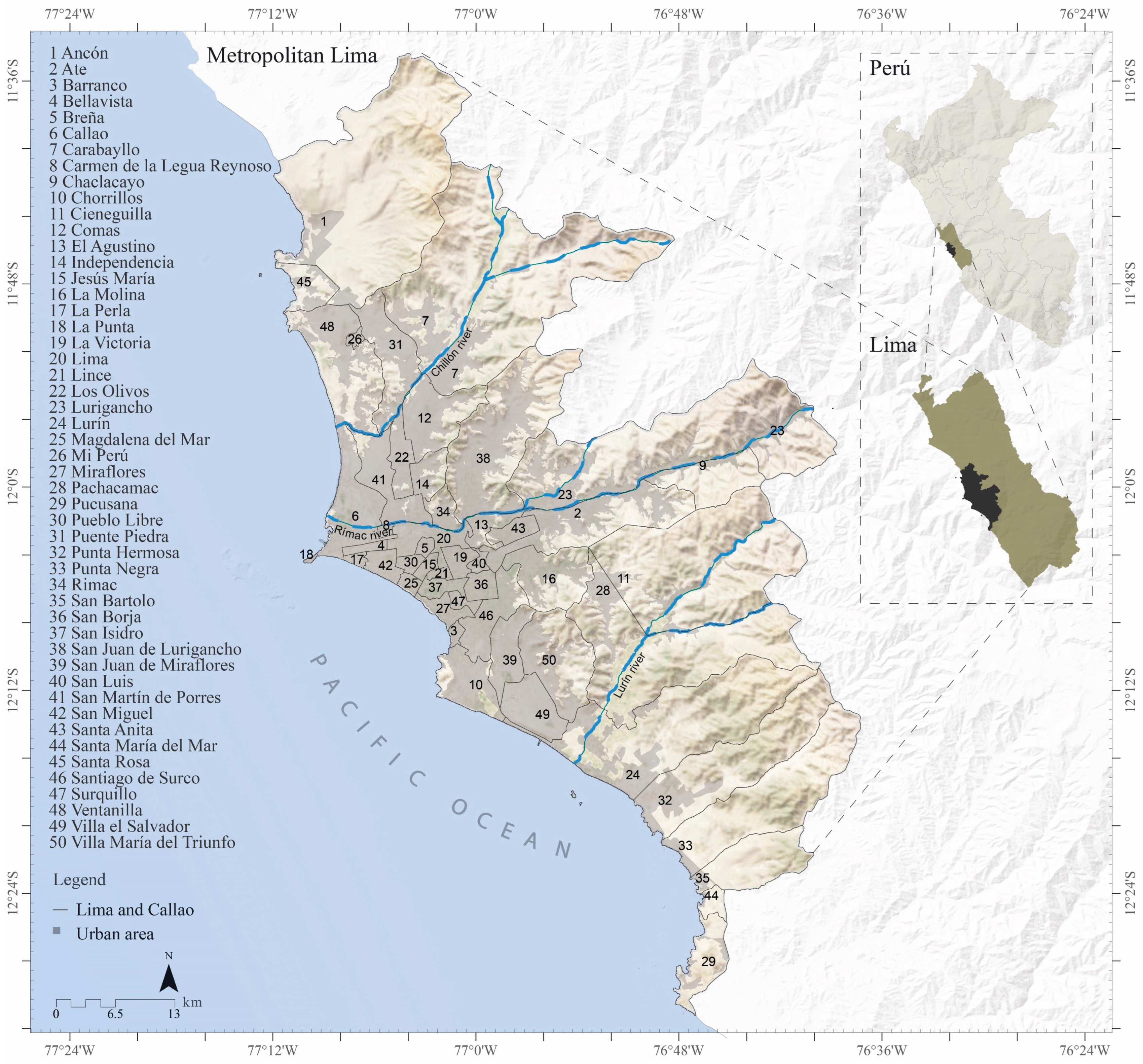
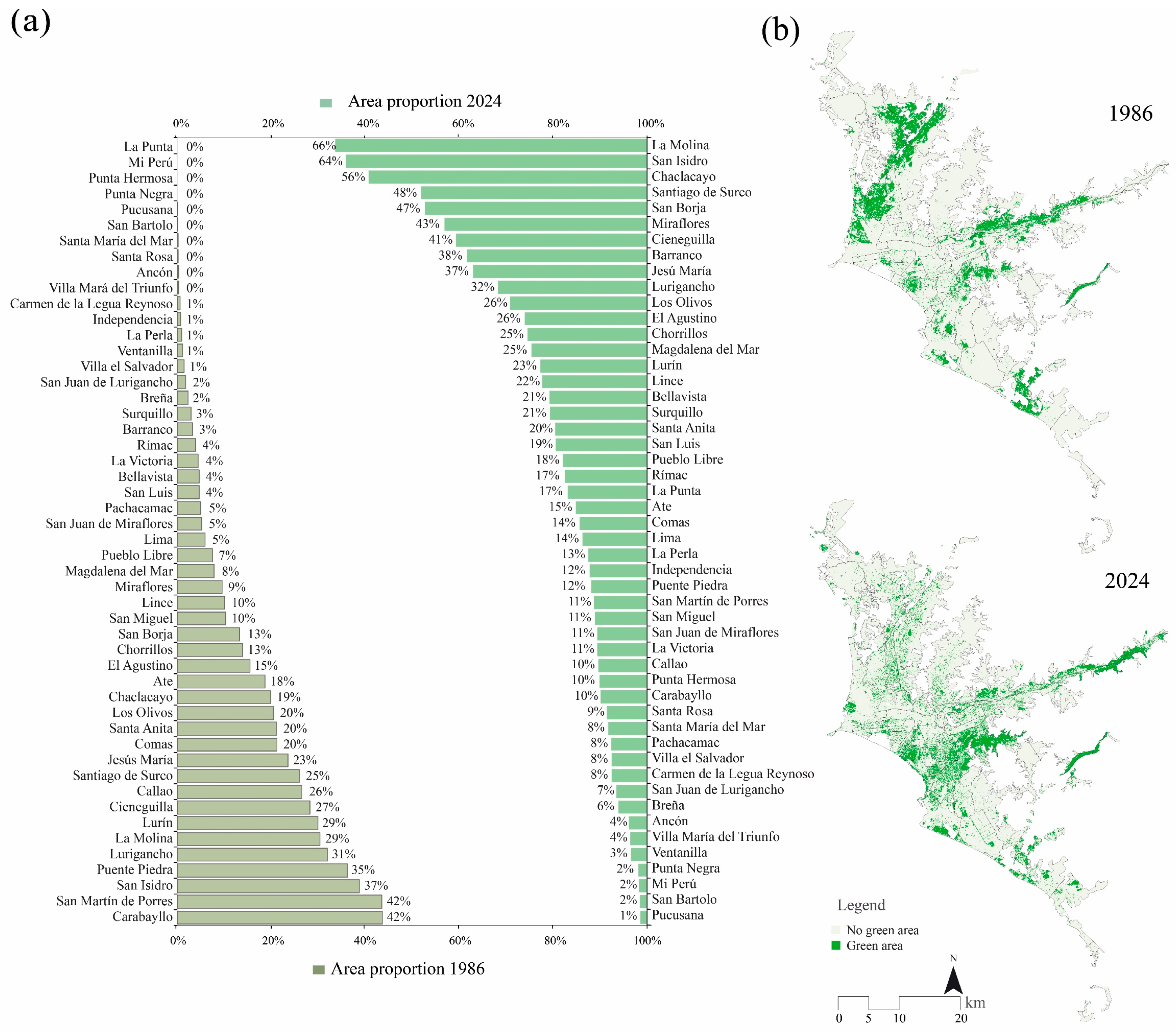
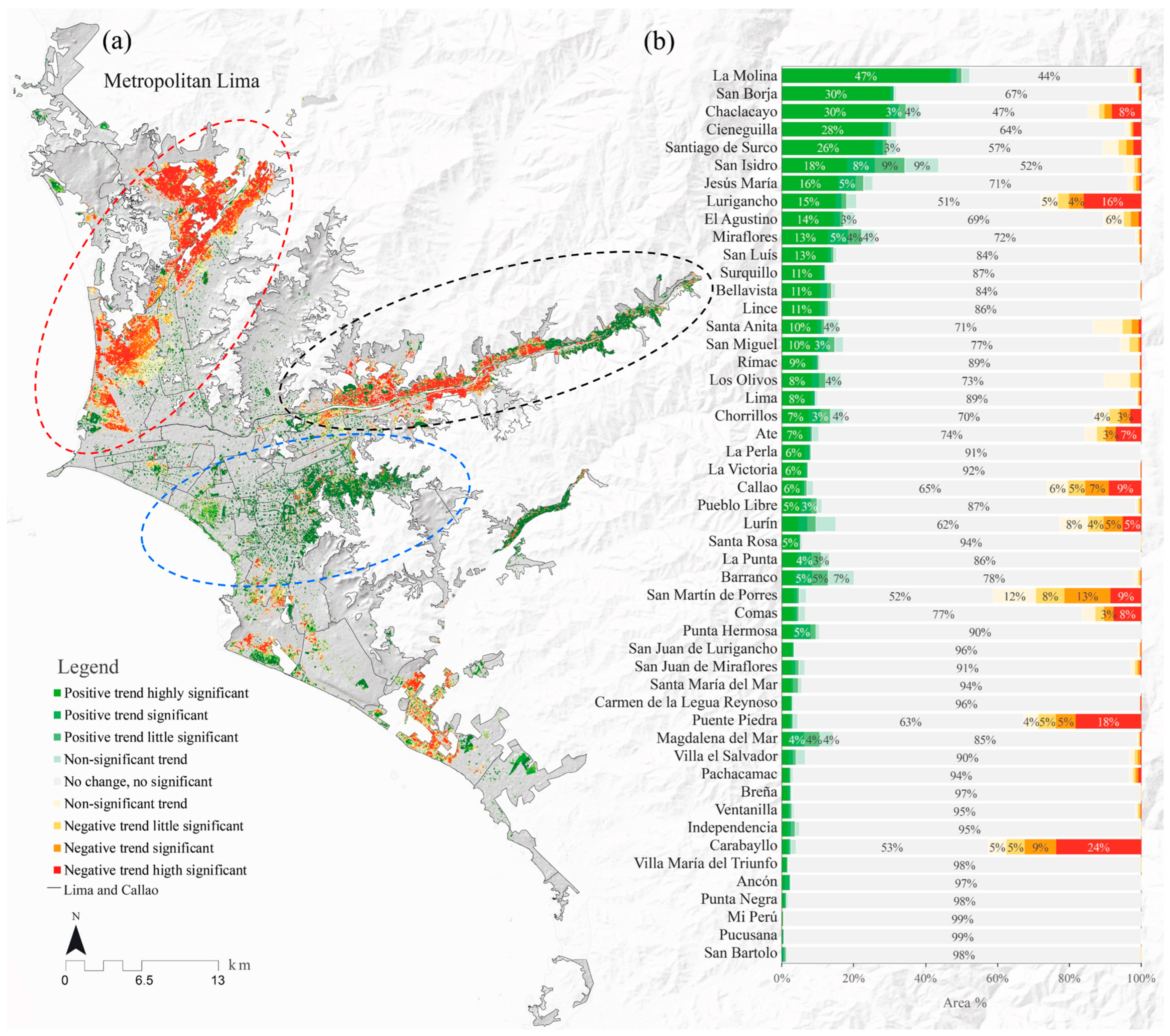
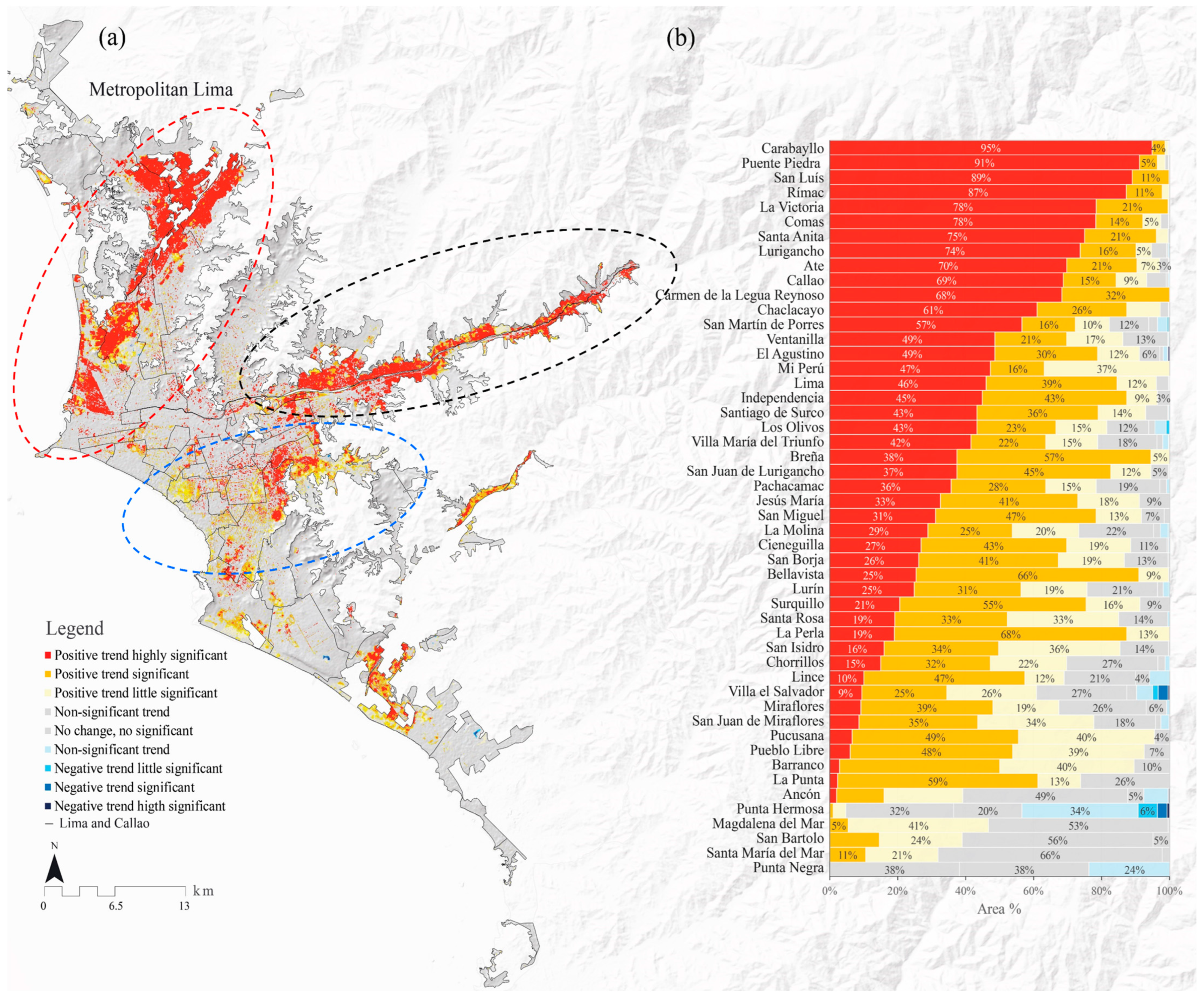

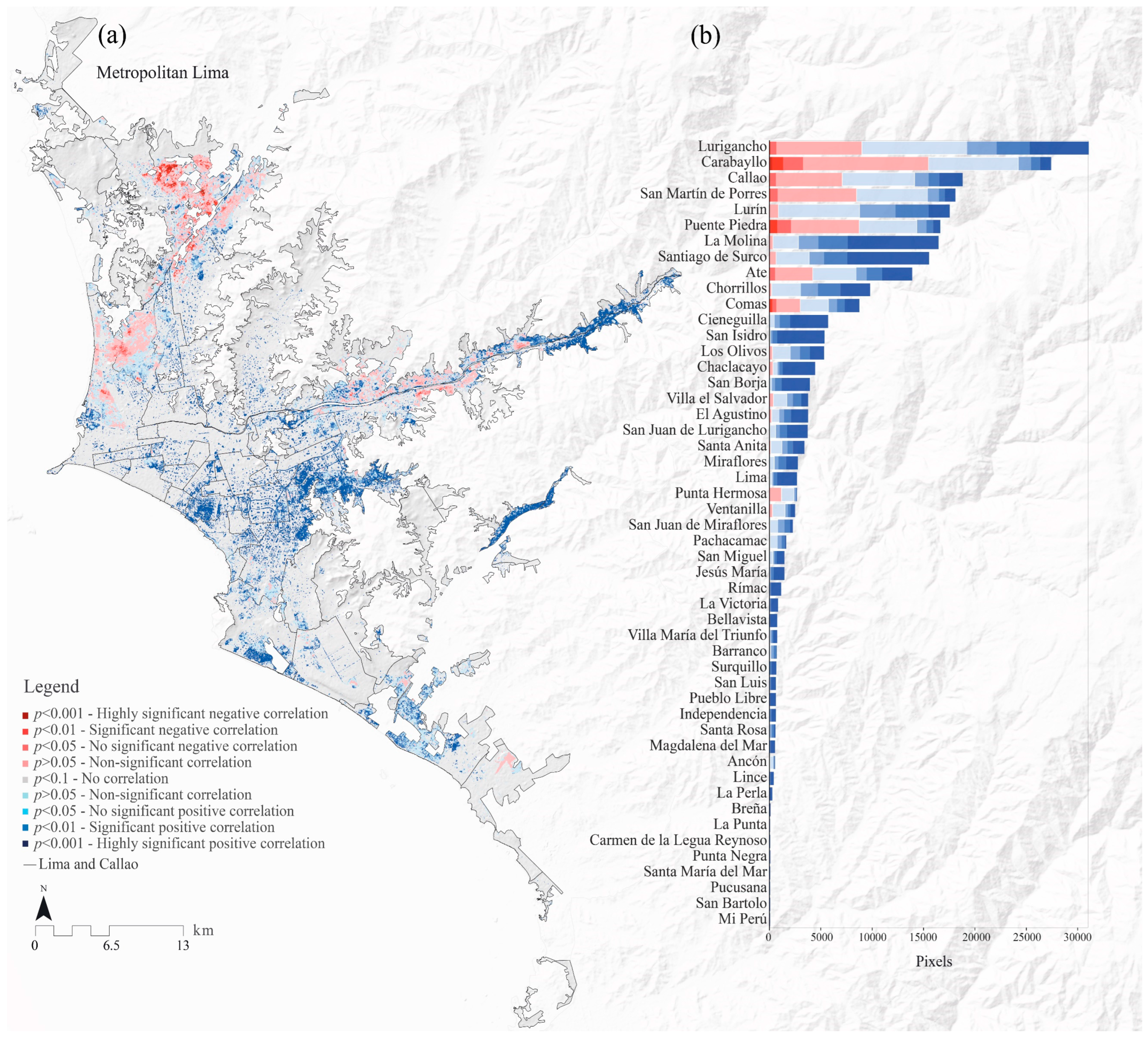
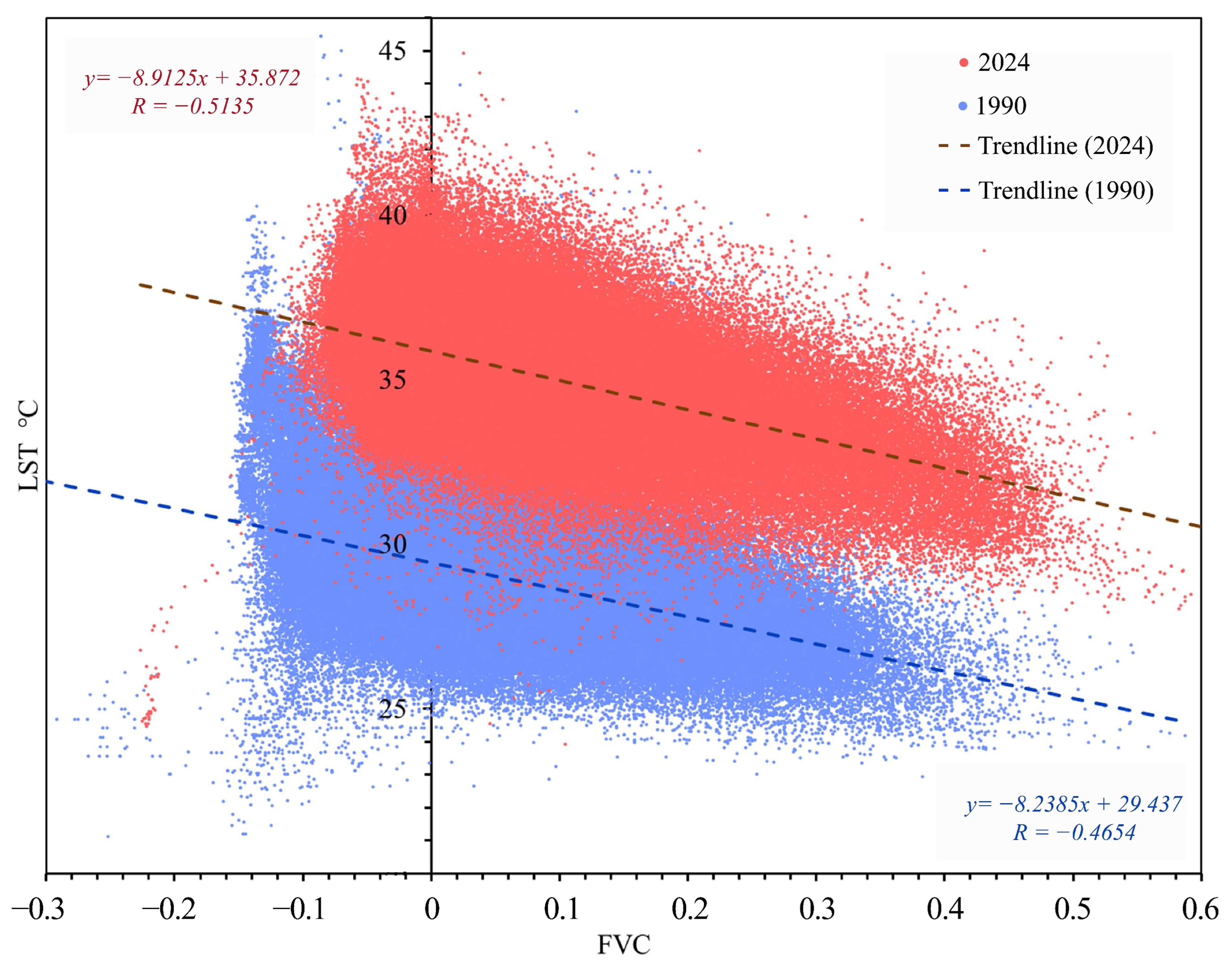
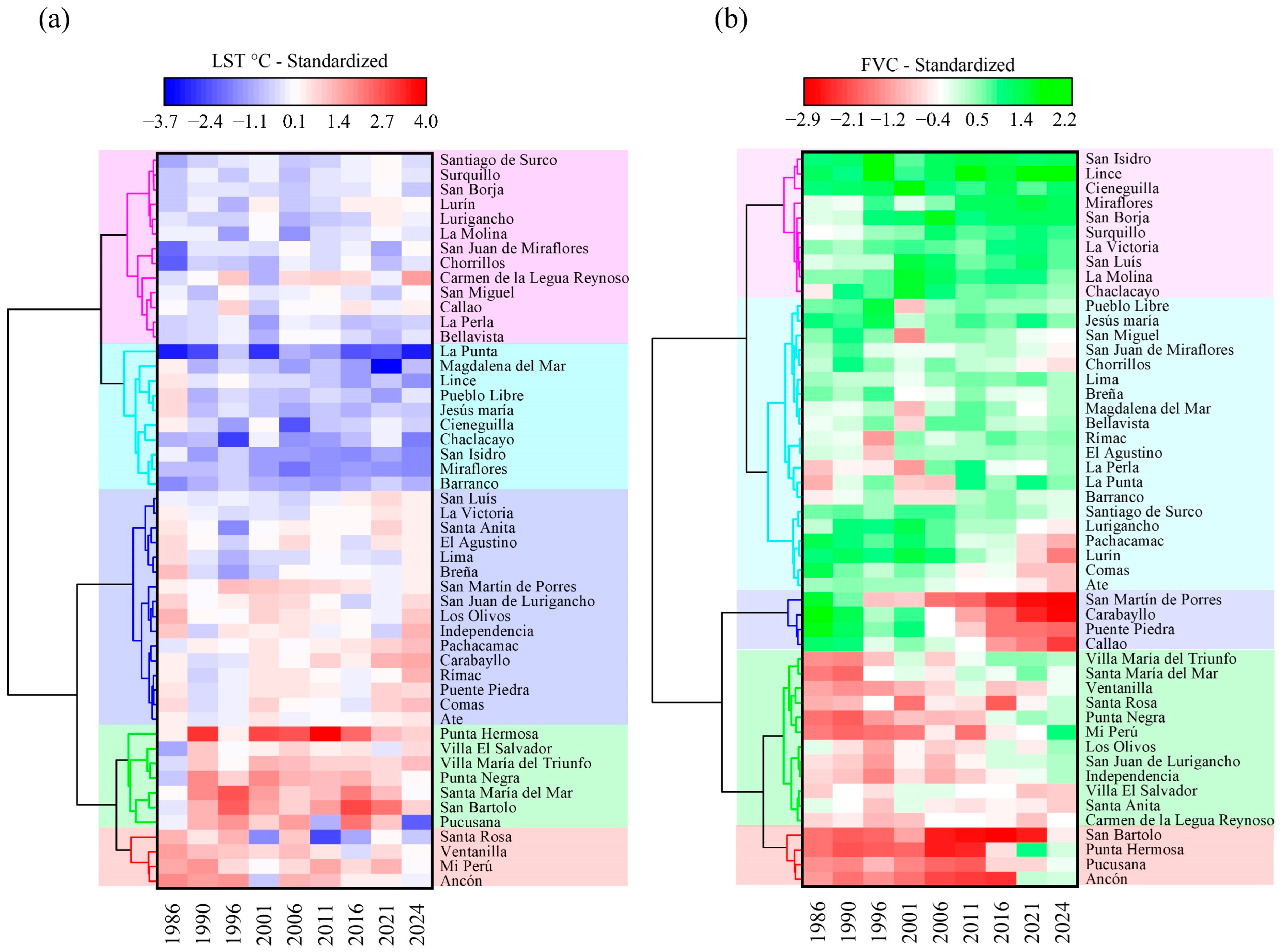
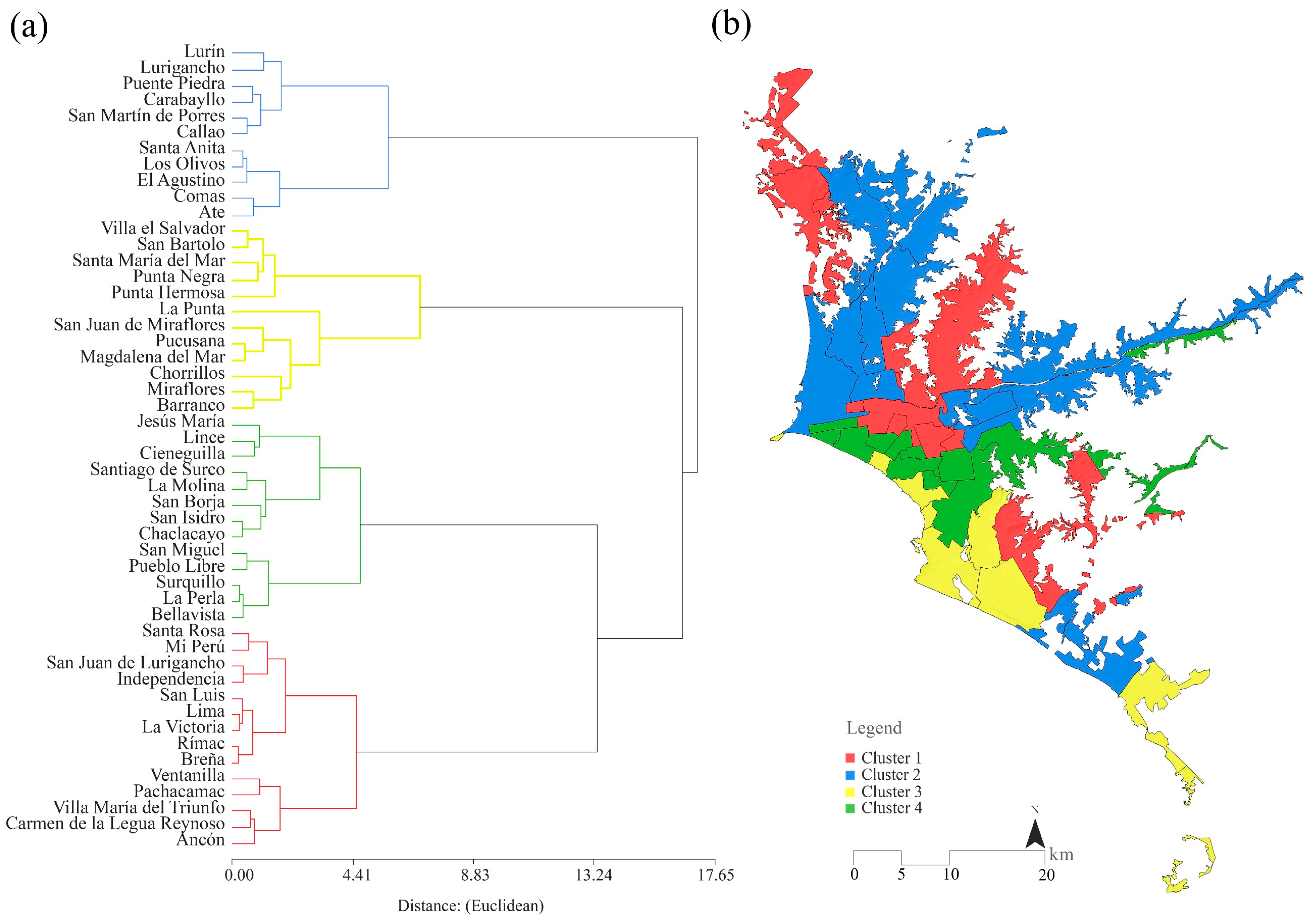
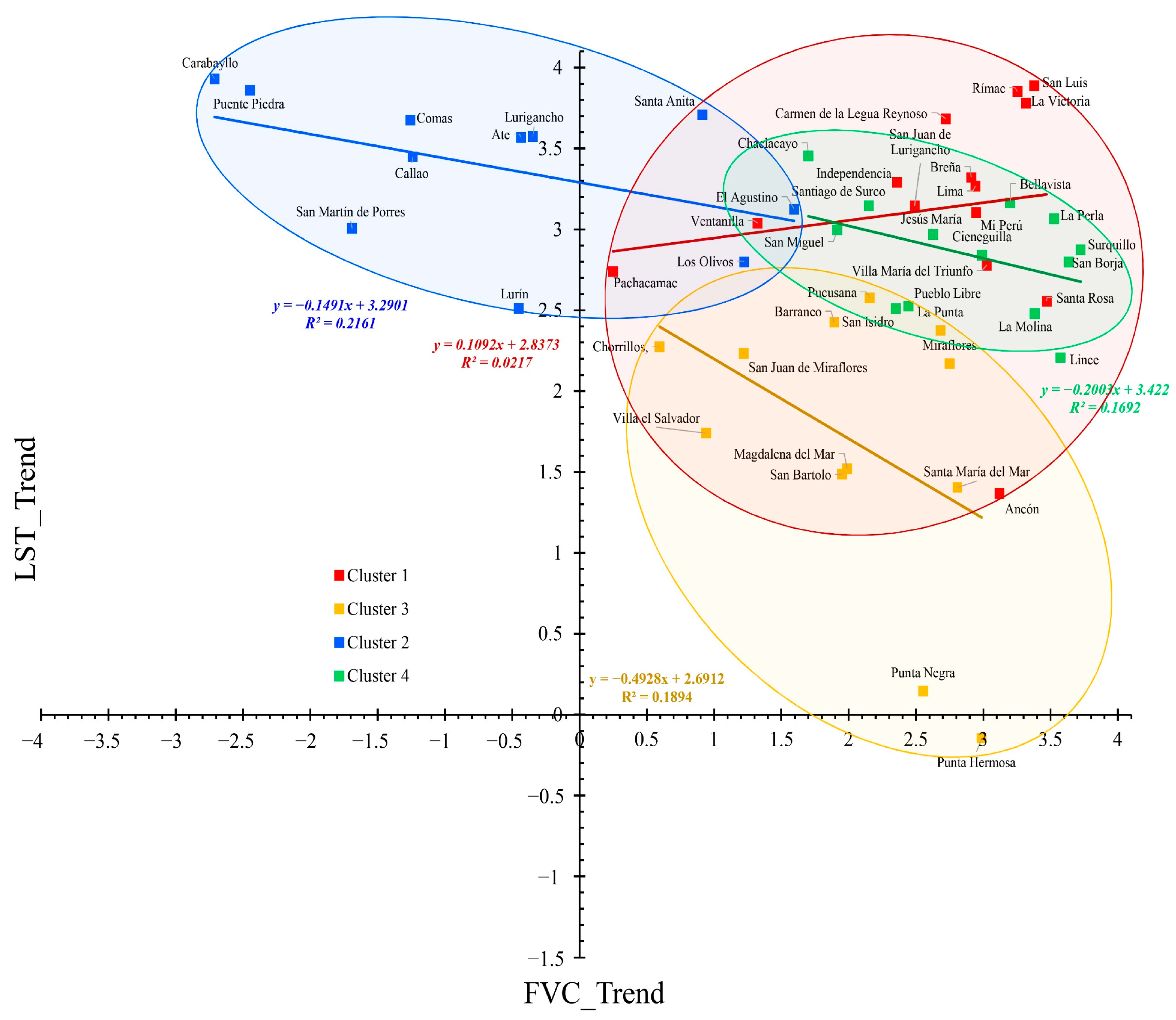
| MK Value Range | Z Value Range | p-Value | Category |
|---|---|---|---|
| <0.001 | Positive trend highly significant | ||
| <0.01 | Positive trend significant | ||
| <0.05 | Positive trend little significant | ||
| <0.1 | Non-significant trend | ||
| >0.1 | No change | ||
| <0.1 | Non-significant trend | ||
| <0.05 | Negative trend little significant | ||
| <0.01 | Negative trend significant | ||
| <0.001 | Negative trend highly significant |
| Indicators | Cluster 1 | Cluster 2 | Cluster 3 | Cluster 4 |
| FVC Trend | Highly significant positive | Highly significant negative | Significant negative | Highly significant positive |
| LST Trend | Highly significant positive | Highly significant positive | Significant positive | Significant positive |
| Correlation | Highly significant positive | Significant negative | Non-significant negative | Highly significant positive |
| Area | Small | Large | Small | Large |
| Interconnection | No interconnection | With interconnection | No interconnection | With interconnection |
| FVC–LST Trend Relationship Line | Non-significant positive | Significant negative | Non-significant negative | Non-significant negative |
| Adjustment Model and R2 | y = 0.1092x + 2.8373 R2 = 0.0217 (p > 0.05) | y = −0.1491x + 3.2901 R2 = 0.2161 (p < 0.05) | y = −0.4928x + 2.6912 R2 = 0.1894 (p > 0.05) | y = −0.2003x + 3.422 R2 = 0.1692 (p > 0.05) |
| Number of Districts | 14 | 11 | 12 | 13 |
| Performance | Acceptable | Deficient | Deficient | Excellent |
Disclaimer/Publisher’s Note: The statements, opinions and data contained in all publications are solely those of the individual author(s) and contributor(s) and not of MDPI and/or the editor(s). MDPI and/or the editor(s) disclaim responsibility for any injury to people or property resulting from any ideas, methods, instructions or products referred to in the content. |
© 2025 by the authors. Licensee MDPI, Basel, Switzerland. This article is an open access article distributed under the terms and conditions of the Creative Commons Attribution (CC BY) license (https://creativecommons.org/licenses/by/4.0/).
Share and Cite
Cano, D.; Cacciuttolo, C.; Rosario, C.; Barzola, R.; Pizarro, S.; Ramirez, D.W.; Freitas, M.; Bremer, U.F. Performance of Green Areas in Mitigating the Alteration of Land Surface Temperature in Urban Zones of Lima, Peru. Remote Sens. 2025, 17, 1323. https://doi.org/10.3390/rs17081323
Cano D, Cacciuttolo C, Rosario C, Barzola R, Pizarro S, Ramirez DW, Freitas M, Bremer UF. Performance of Green Areas in Mitigating the Alteration of Land Surface Temperature in Urban Zones of Lima, Peru. Remote Sensing. 2025; 17(8):1323. https://doi.org/10.3390/rs17081323
Chicago/Turabian StyleCano, Deyvis, Carlos Cacciuttolo, Ciza Rosario, Renato Barzola, Samuel Pizarro, Dámaso W. Ramirez, Marcos Freitas, and Ulisses F. Bremer. 2025. "Performance of Green Areas in Mitigating the Alteration of Land Surface Temperature in Urban Zones of Lima, Peru" Remote Sensing 17, no. 8: 1323. https://doi.org/10.3390/rs17081323
APA StyleCano, D., Cacciuttolo, C., Rosario, C., Barzola, R., Pizarro, S., Ramirez, D. W., Freitas, M., & Bremer, U. F. (2025). Performance of Green Areas in Mitigating the Alteration of Land Surface Temperature in Urban Zones of Lima, Peru. Remote Sensing, 17(8), 1323. https://doi.org/10.3390/rs17081323













